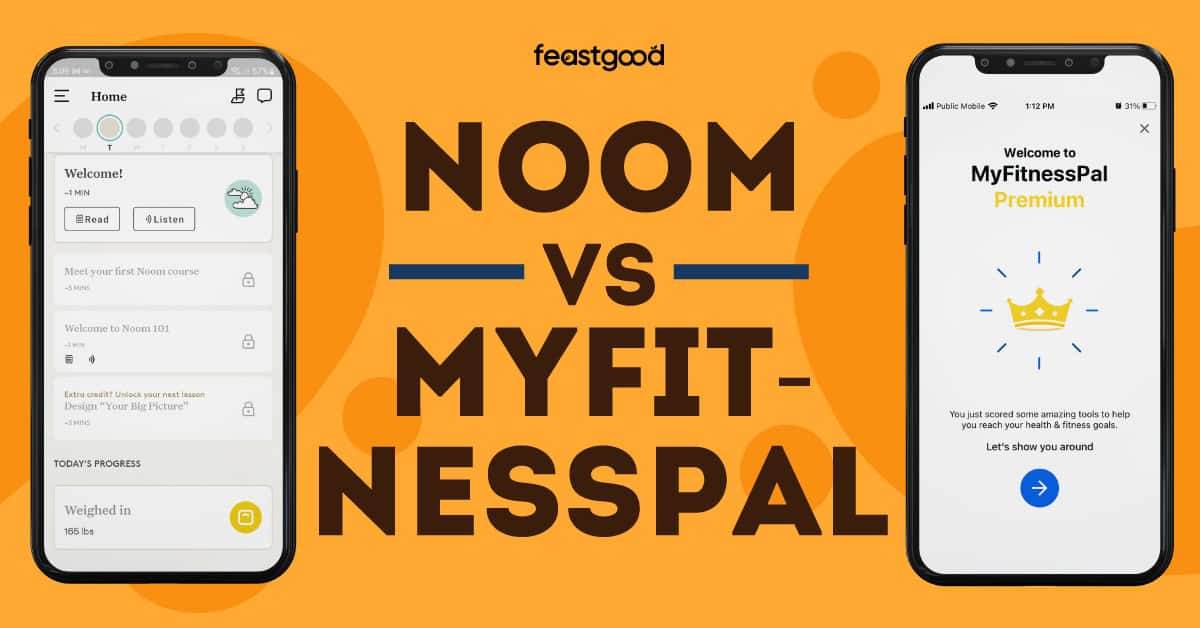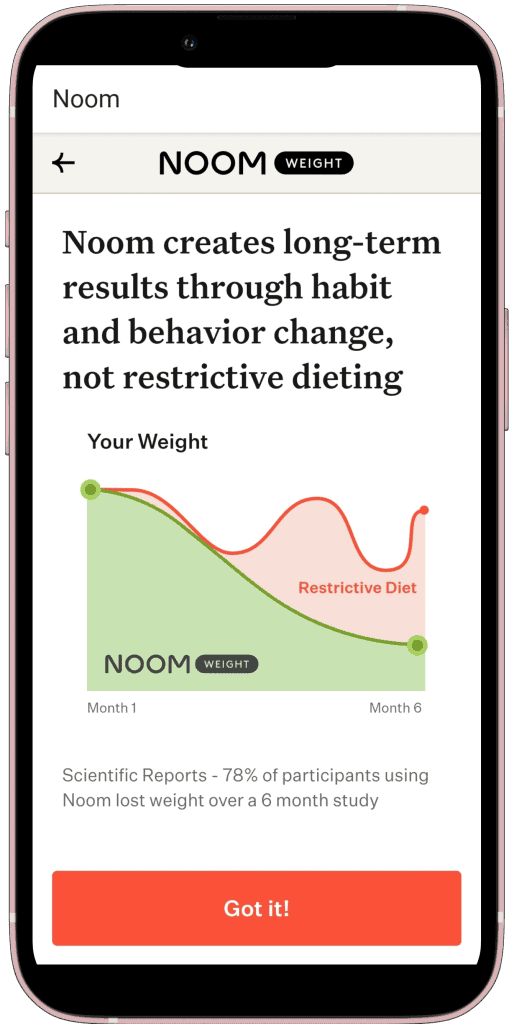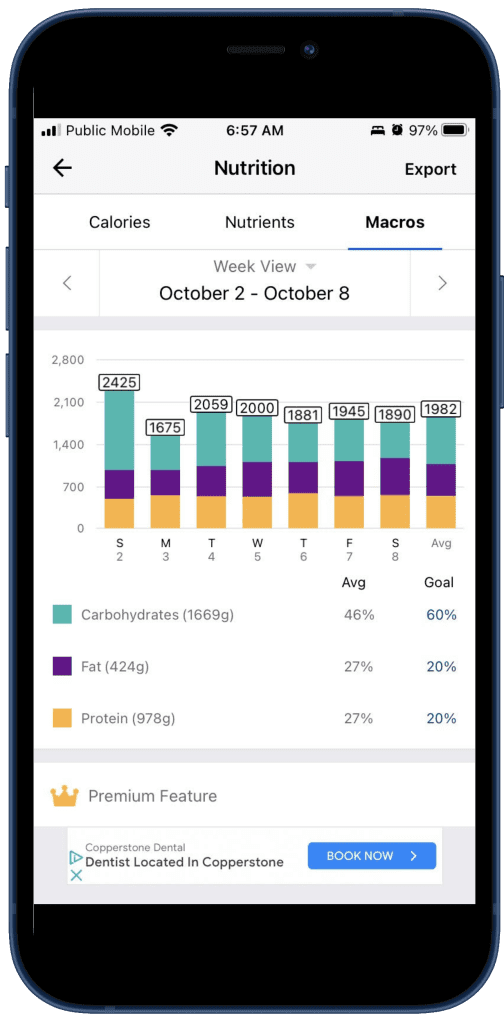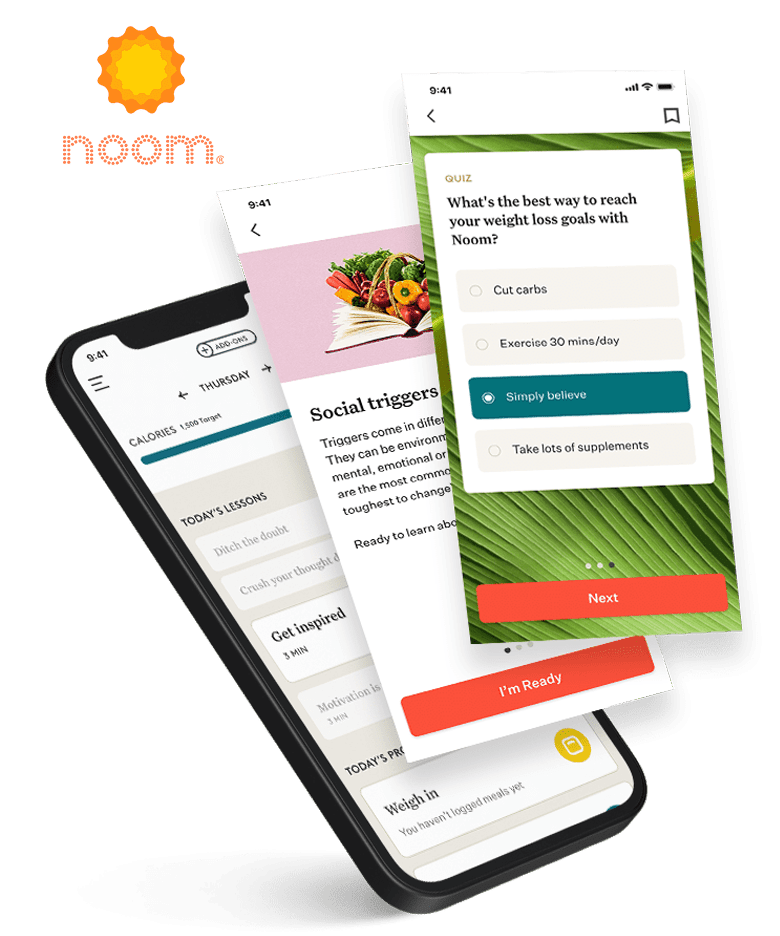I’ve used MyFitnessPal for years but more recently I tried Noom to see what the hype was about. Now that I’ve used both nutrition apps extensively, I know the pros and cons of each app and can make recommendations for which app is best for specific needs.
Key Takeaways
- The main difference between Noom and MyFitnessPal is that Noom is a weight loss app focused on food quality (splitting foods into specific categories), daily education, and behavioral psychology. MyFitnessPal is simply a food logging app focused on calorie and macro tracking.
- Noom is the better option for beginners focused on weight loss or those who haven’t been successful in losing weight in the past. It educates users on healthy and sustainable nutrition and emphasizes the importance of behavioral change and mindset.
- MyFitnessPal is best for those who want a calorie and macro tracker. It has a large food database, including restaurant items and international foods. Users with both weight gain and weight loss goals can use MyFitnessPal successfully, but the app will not tell you how many calories or macros to eat.

Overall Rating: 4.8/5

Overall Rating: 3.7/5
Medical Disclaimer: The content of this article is provided for educational insights only. It should not be used as medical guidance. Individuals with a past of disordered eating should refrain from weight loss programs or calorie tracking. For medical advice, consult a certified healthcare professional. If you’re struggling with eating disorders, contact NEDA for assistance.

What Is Noom?
Noom is a nutritional app primarily designed to help people lose weight by providing a calorie range, classifying foods based on their caloric and nutritional value, and focusing on behavioral changes.
Instead of giving users a fixed calorie target, Noom uses a range to emphasize the importance of dietary flexibility, even when the goal is weight loss. It also places foods in three categories:
- Green: foods with great nutritional value and fewer calories (e.g., fruits and veggies). These foods should make up a large percentage of your diet (~70%).
- Yellow: foods with decent nutritional value with a moderate number of calories per serving (e.g., meat, legumes, dairy, etc.). These foods should be consumed in moderation.
- Red: foods with the highest number of calories per serving. Red foods aren’t necessarily unhealthy foods (e.g., nuts & seeds) but they should be eaten in limited quantities to increase their calorie content.
The app teaches users to approach their nutrition with balance and to avoid unnecessary restrictions that prevent sustainability.
What makes Noom unique from other weight loss apps, is that it provides users with daily psychology and nutrition lessons to encourage behavior change.
This allows the user to understand how to make lifestyle changes that will help them keep weight off, rather than focusing on quick fixes that will lead to weight regain.
Want to learn more? Read my in-depth experience testing Noom here.
Pros
- Places emphasis on behavioral changes and mindset
- Focuses on user education with daily lessons
- Provides a calorie range for greater dietary flexibility
- Encourages balance with food color categorizations
- Access to a coach and community support
Cons
- Users cannot track their macronutrient intake (proteins, carbs, and fats)
- It adds calories burned back into your total intake
- The calorie range is too large which decreases the accuracy
What Is MyFitnessPal?
MyFitnessPal is the oldest and most popular macronutrient-tracking app on the market, which is why most people turn to MyFitnessPal when they want to start calorie counting or macro tracking.
One of the best things about MyFitnessPal is how easy it is to use. Its set-up process and design are very straightforward, making it easy to use even if you’ve never tracked your intake before.
MyFitnessPal works by asking users about their age, height, weight, activity level, and goals. Using this information, it generates nutritional targets (calories & macros) for users to adhere to, to work toward their goals.
The basic nutrition targets the app recommends tend to be lower than necessary for those with a goal of losing weight, but users can manually override them if they feel they are inaccurate.
For instance, if the calorie recommendations feel too low, you can write a higher target and change your macronutrient goals (to the closest 5% on the free version).
Users can log their foods through a combination of manual inputting (writing down the food, its quantity, and the nutritional value), searching through the library with keywords (e.g., broccoli), and using the barcode scanner (only available to premium users).
MyFitnessPal has a large food database; however, it’s notorious for having tons of inaccurate food entries. For this reason, users must double-check the nutritional information before adding it to their food diary.
Want to learn more? Read my in-depth experience testing MyFitnessPal here.
Pros
- The app’s interface is intuitive and easy to use
- There are lots of restaurant foods with nutritional information in the database
- Even the free version allows for basic calories and macronutrient tracking
Cons
- There are a lot of inaccurate food entries in the database
- Many of the better features (e.g., barcode scanner) are only available on the premium version
- The free version has lots of ads, which can be frustrating
- The calorie recommendations are often lower than they should be
Noom vs. MyFitnessPal: Head To Head Comparison
To determine which nutrition app is better, we’ve compared them in the following 10 categories.
1. Food Database
Noom
Noom has the most comprehensive and reliable food database, with 3.7+ million options to pick from… according to Noom.
While undoubtedly impressive, users often report inaccuracies. For instance, the grilled chicken sandwich from Chick-fil-A is listed to have 320 calories in Noom but 390 calories on the restaurant’s website.
That said, Noom’s calorie range is designed to account for these discrepancies so users can likely still make meaningful progress toward their goal despite some entries being inaccurate.
MyFitnessPal
MyFitnessPal’s food database is enormous but it’s also unverified, which is why It has millions of inaccurate entries. That said, because of the vast number of entries in its database there are more options for those working and traveling internationally and tons of restaurant menu items.
The inaccuracies can be easy to spot for experienced macro trackers, but beginners may not know when an entry is inaccurate.
The Winner: MyFitnessPal
MyFitnessPal and Noom’s databases are both known for having inaccuracies. However, I’m declaring MyFitnessPal as the winner in this category because it has a larger database that is more accommodating for people living or traveling internationally and has more restaurant options than Noom.2. Tracking Capabilities
Noom
Noom allows users to track their calorie intake, calories burned through physical activity and exercise, step count, body weight, blood pressure, and blood sugar levels.
MyFitnessPal
MyFitnessPal gives users the ability to track their calories, macronutrients (proteins, carbs, and fats), six micronutrients (vitamins A and C, iron, calcium, potassium, and sodium), step count, exercise activity, body weight, body fat percentage, and some circumference measures.
The Winner: MyFitnessPal
MyFitnessPal is the winner in this category because it allows users to track more variables. Noom lacks some important tracking capabilities, mainly the ability to track macronutrients. By only focusing on calories (and not macros), users may be severely under-consuming important nutrients (i.e. protein) and not know it.3. Calorie Recommendations
Noom
Noom provides a calorie range instead of a fixed target, which creates more dietary flexibility. However, the range tends to be large, making it difficult for users to tell if they are eating the appropriate number of calories for their weight loss goals.
My assessment of Noom’s recommendations is that the lower end of the range is too low and could lead to rapid (unhealthy) weight loss, muscle loss, and extreme hunger. For this reason, I recommend aiming for the middle or upper end of the calorie range provided.
For example, if your range is 1,500 to 2,100, perhaps aim for 1,800+ calories.
MyFitnessPal
MyFitnessPal’s nutritional recommendations also tend to be lower than what is recommended and they are provided as a fixed value, rather than a range like Noom.
One of the major benefits of MFP is that users can override their nutritional targets on MyFitnessPal if they feel they are inaccurate. The free version allows users to modify their macronutrients to the closest 5%, whereas premium users can set specific protein, carb, and fat gram goals.
The Winner: Noom
Noom takes the win because of their calorie range which creates more flexibility and encourages better dietary adherence than MyFitnessPal’s fixed target.I do appreciate that MFP allows you to set your own targets, but not every user will know how to set appropriate targets.
4. Level of Customization
Noom
Noom doesn’t have many opportunities for customization apart from the ability to change your calorie range and daily step goal.
However, one thing that I appreciate about the available customizations is that before changing your calorie goals, the app educates you on energy intake and when it might make sense to increase it so that you aren’t changing targets unnecessarily.
MyFitnessPal
MyFitnessPal is similar to Noom in this category, allowing users to modify their nutritional targets and daily steps goals. Other than that, there isn’t much you can change inside the app.
The Winner: Noom
While both apps allow calorie adjustments, I consider Noom the better option because, on top of allowing users to modify their dietary goals, it teaches people when and how to change their targets to stay on track with their goals.5. Educational Opportunities
Noom
Noom focuses heavily on education, mindset, and behavioral changes. It shares new lessons daily and provides engaging quizzes for users to test their knowledge on these topics.
The app also teaches users about the energetic value of each food and how to make better nutritional choices for calorie control and weight loss.
MyFitnessPal
MyFitnessPal isn’t meant to be an educational app. It only helps users better understand the nutritional value of various foods and how they might fit within specific calorie and macronutrient targets.
The Winner: Noom
Noom is the clear winner in this category, thanks to its emphasis on educating users on proper nutrition and behavior changes. It sends daily lessons and quizzes to users to test and solidify their knowledge.For this reason, Noom is more likely to lead to sustainable habits and behaviors that help users lose weight and keep it off long-term.
6. Coaching
Noom
Unlike many nutritional apps on the market, Noom allows users to speak to a coach through their Live Chat feature.
I tested the feature to see how responsive my coach was and how good their advice was. To my surprise, they were helpful and provided some valuable and specific tips.
MyFitnessPal
Unlike Noom, MyFitnessPal doesn’t offer any coaching.
If you’re working with a nutrition coach and using MFP to track, you can export your food log to share it with your coach.
The Winner: Noom
While MyFitnessPal can be a valuable tool in a coach-client relationship, Noom is the winner in this category because it has a built-in coach. Users can contact a coach through the Live Chat feature for support and guidance.7. Recipe Database
Noom
The Noom app has a decently sized recipe library with breakfast, lunch, dinner, and snack options. Each recipe includes the calories per serving and the percentage of green, yellow, and orange foods to help users gauge the nutrient quality of the recipe.
Users can easily find recipes by typing keywords (e.g., chicken) in the search bar.
MyFitnessPal
MyFitnessPal has a Recipe Discovery feature that allows users to find many recipes based on category or hashtag. For instance, someone following a vegan diet can include the keyword vegan in the search bar and get more relevant recipe recommendations.
The Winner: Tie
It’s difficult to declare a winner in this category, as both apps have decent recipe databases, and users can find many recipes with keywords like chicken, vegan, etc.8. Exercise Calories
Noom
Like other apps, Noom allows users to log their exercise activity but it also estimates the number of calories that you burn based on your daily step count.
The app estimates the total number of calories burned, takes 50 percent of the total value, and adds it to your daily calorie range.
For instance, say you’ve burned 400 calories from a running session. Noom will add 200 calories to your range, allowing you to maintain the same deficit by eating a bit more food.
Not everyone enjoys the feature because it doesn’t allow you to use all the calories burned through exercise to contribute to your calorie deficit. There is also no option to turn this feature off.
MyFitnessPal
MyFitnessPal can track exercise calories but can not track activity calories (calories burned from steps) unless you sync it with a smartwatch. Premium users of MFP have the option to ignore the energy burned during exercise or add it to their total.
The Winner: MyFitnessPal
The fact that MyFitnessPal gives users the choice of what to do with the calories burned during exercise makes it the winner. Noom’s rigid structure could add unnecessary complexity (especially for beginners) and make it harder to lose weight if you’re eating at the top end of your calorie range.9. Price
Noom
Noom is easily one of the most expensive nutrition apps on the market. The annual plan is the best deal at $209 (billed upfront), which comes out to $17.41 monthly.
Other options include a monthly plan, which costs $70, and a quarterly plan, priced at $169 (billed upfront).
The app is cheaper than hiring a nutrition coach, and the emphasis on education and behavioral changes is extremely valuable.
However, there are some drawbacks (not tracking macronutrients and not allowing for much customization) that may make it more difficult for some people to justify the price.
MyFitnessPal
MyFitnessPal can be used for free for those who just want basic tracking capabilities. However, those who want all the bells and whistles will need a premium subscription.
The annual plan costs $79.99 (paid upfront) and comes out to just $6.66 per month, or there is a monthly subscription of $19.99.
The Winner: MyFitnessPal
Despite its unique approach to nutrition and cool features, it’s difficult to justify Noom’s price considering it doesn’t have all the features you may want in a nutrition app (i.e. macros).That said, people who have always struggled with weight loss might find that Noom is well worth the price simply for the behavioral psychology lessons.
MyFitnessPal has a better price, making it more accessible to a wider audience.
- Related Article: Apps Like Noom But Cheaper
10. Reviews
Noom
Noom has an impressive 4.7-star rating on the App Store with 793,000+ reviews and 4.1 stars with 306,000+ ratings on Google Play.
Many of Noom’s negative reviews stem from the inaccuracies found in the food database.
MyFitnessPal
MyFitnessPal has a 4.1-star rating on Google Play with 2.6+ million reviews and 4.7 stars with 1.7+ million reviews on the App Store.
The app’s rating on Google Play fell by more than 0.5 stars in recent months, which is quite worrisome for an app with that many reviews. Most complaints revolve around losing access to previously free features (such as the barcode scanner) and struggling to navigate the app with all the ads.
The Winner: Tie
MyFitnessPal should be the winner because it has millions of reviews and ratings similar to Noom. However, we are reluctant to declare it the winner in this category because many of the app’s negative reviews have come in since November 2022.Noom vs. MyFitnessPal: Quick Overview
| Noom | MyFitnessPal | Our Interpretation | |
|---|---|---|---|
| Food Database | The app has a large food database, but it is known for having some nutritional inaccuracies. | It has millions of entries and lots of restaurant meals with nutritional information, but many of these entries are inaccurate. | Both apps are known for inaccuracies, but MyFitnessPal is slightly better because it makes it easier to track restaurant meals. |
| Tracking Capabilities | • Calorie intake • Exercise calories • Steps taken • Body weight • Blood pressure • Blood sugar levels | • Calories • Protein • Carbs • Fats • Vitamins A and C, Sodium, Calcium, Potassium, and Iron • Exercise activity • Steps taken • Circumference measures | MyFitnessPal allows users to track more variables than Noom. |
| Calorie Recommendations | It provides a large calorie range, which offers dietary flexibility, even during weight loss. | It provides a fixed calorie target that’s fairly accurate but could be more stressful to hit. | Noom’s calorie range allows for better dietary adherence and could be more useful for weight loss. |
| Level of Customization | Users can customize their calorie target if necessary. | MyFitnessPal users can modify their calories and macronutrients. | We consider Noom superior because the app educates users on when and how to make changes in addition to its customizability. |
| Educational Opportunities | Noom teaches users about behavior change and sustainable nutrition through daily lessons, articles, and quizzes. | MyFitnessPal is not meant as an educational app. | Noom is the clear winner here because it focuses far more on changing habits and behaviors for life. |
| Coaching | Noom users can reach out to a coach through the Live Chat feature for support and guidance. | MyFitnessPal doesn’t offer any ‘in-house’ coaching for users. | Noom is a better resource for coaching because it has a built-in coach for each user. |
| Recipe Database | Noom has a decently sized recipe library with a search bar. | The app has a Recipe Discovery feature that allows users to search for recipes based on category or hashtag. | Both apps have similar recipe databases and search functions. |
| Exercise Calories | Noom calculates calories burned during exercise and adds 50% of those calories burned to the day’s calorie range. | MyFitnessPal tracks the energy burned during exercise. Premium users can choose whether to add the calories to their total or ignore them. | MyFitnessPal is slightly better here because it allows users to choose what to do with exercise calories. |
| Price | Noom’s annual plan is $209 (billed upfront). The monthly plan costs $70, and the quarterly plan is $169 (billed upfront). | MFP has a free version with basic functions. The app’s annual plan costs $79.99 (paid upfront). There is also a monthly plan that costs $19.99. | MyFitnessPal is the more affordable app. |
| Reviews | Noom has a 4.7-star rating with 793,000+ reviews on the App Store and 4.1 stars with 306,000+ reviews on Google Play. | MyFitnessPal has 4.1 stars, with 2.6+ million reviews on Google Play, and 4.7 stars, with 1.7+ million reviews for iOS. | We can’t pick a winner, given their similar ratings. MyFitnessPal has had many negative reviews that have recently caused its Google Play rating to drop by 0.6 stars. |
Who Should Use Noom?
Noom is best for people who want:
- Education on healthy and sustainable nutrition
- To improve their relationship with food
- To learn about the nutritional impact of various foods
- More flexibility in their approach to weight loss
- To understand why their previous diet attempts might have been unsuccessful
Who Should Use MyFitnessPal
MyFitnessPal is best for:
- Easy calorie and macronutrient tracking
- People with experience monitoring their nutrition for weight loss or gain
- Those who travel internationally and need a global database
- Folks who frequently eat meals at restaurants
Read More App Comparisons
About The Author

Philip Stefanov is a certified conditioning coach, personal trainer, and fitness instructor. With more than nine years of experience in the industry, he’s helped hundreds of clients improve their nutritional habits, become more consistent with exercise, lose weight in a sustainable way, and build muscle through strength training. He is passionate about writing and has published more than 500 articles on various topics related to healthy nutrition, dieting, calorie and macronutrient tracking, meal planning, fitness and health supplementation, best training practices, and muscle recovery.
Why Trust Our Content

On Staff at FeastGood.com, we have Registered Dietitians, coaches with PhDs in Human Nutrition, and internationally ranked athletes who contribute to our editorial process. This includes research, writing, editing, fact-checking, and product testing/reviews. At a bare minimum, all authors must be certified nutrition coaches by either the National Academy of Sports Medicine, International Sport Sciences Association, or Precision Nutrition. Learn more about our team here.
Have a Question?
If you have any questions or feedback about what you’ve read, you can reach out to us at [email protected]. We respond to every email within 1 business day.



